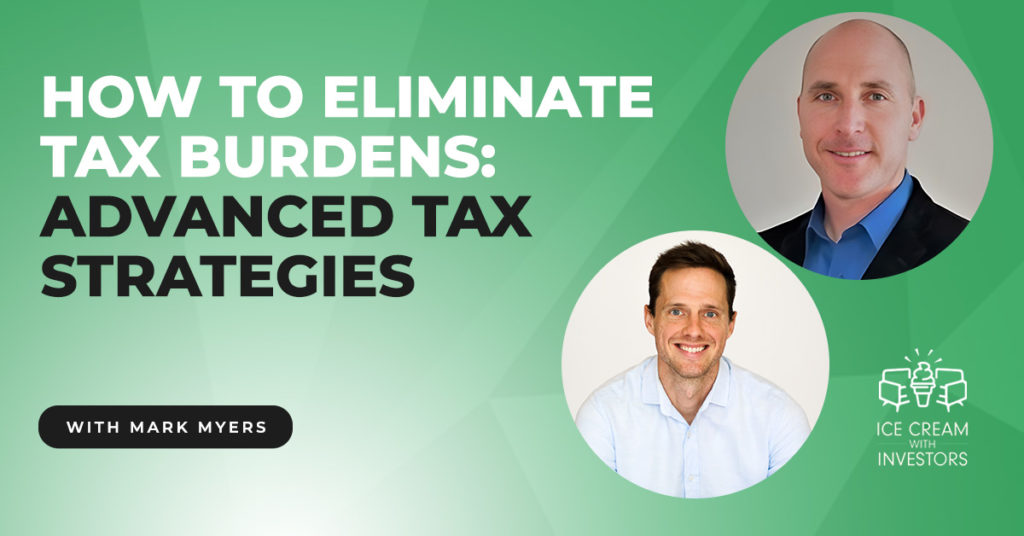How much are you keeping for every dollar you make? Taxes can become the bane of your financial existence, especially if you don’t know how to handle and navigate them. Here to share advanced tax strategies to help reduce or even eliminate your tax burdens is Mark Myers. Mark is the Founder of Peak Profit Solutions, helping thousands of individuals increase profit and permanently reduce their annual tax bills to better grow their business and accelerate their wealth. In this episode, he joins Matt Fore to share how you can use the tax code to your advantage and keep more profit. It’s all about planning ahead and knowing which investments to make. Mark goes through the different real estate benefits, the solar tax credit, charitable giving, and other opportunities. Learn different ways you can stop losing money in taxes by tuning in.
Guest Links
Email: Mark@PeakProfitSolutions.com
Website: PeakProfitSolutions.com
Phone Number: 310-591-0234
LinkedIn https://www.linkedin.com/in/markshannonmyers/
—
Listen to the podcast here
How To Eliminate Tax Burdens: Advanced Tax Strategies With Mark Myers
In this episode, we have Mark Myers on. He is the Founder and CEO of Peak Profit Solutions, where he helps individuals reduce and eliminate tax burdens without replacing their CPA or financial advisor. His company, Peak Profit Solutions, and its affiliates partners have helped thousands of individuals increase their profits and permanently reduce their annual tax bill to help them better grow their businesses and accelerate their wealth. Mark, welcome to the show.
Matt, thanks so much. I’m looking forward to some ice cream.
We like to start with the difficult questions here. What is your favorite ice cream?
Mint chocolate chip all the way.
Tell me why.
I’m a chocolate fan but the mint has that crisp, clean taste to it. I grew up loving the mint chocolate chip Girl Scout cookies, and now, you turn it into ice cream, and you can’t get any better.
Our readers know that’s the answer. I give the most mint chocolate chip because when I was a kid, my father used to tell me, “Always order mint chocolate chip because no one else likes that, so you can keep it all to yourself. No one will ask you for a taste.”
That’s good advice. I love that advice.
Tell our readers, what’s the scoop? What do you do?
The scoop is when it comes to keeping more of what you work hard to earn. That’s the scoop. That is what I like to help people with. It’s keeping more of their hard-earned profit, and when you think about it, nobody likes to pay retail for anything, particularly in real estate. You make your money on the purchase. You have to find a deal. You are not going to pay the rack rate.
The same applies to anything but particularly taxes. There are 75,000 pages of tax code, and there are plenty of coupons that you can clip if you know how to navigate those pages. The scoop is to make sure people know that they are not overpaying because most people are paying retail and could be paying wholesale in taxes legally.
I want to dig in here. I’ve heard you say on previous podcasts that there are two different tax systems. One for the informed and one for the uninformed. Can you tell us a little bit about what the unwritten rules are for the informed taxpayer?
That statement was made by Judge Learned Hand, and he was a very well-known Second Circuit Appellate Judge in the tax system. It has to do with understanding that code and taking the time to apply it in the right situation. He also said it’s not any one individual’s obligation or constitutional obligation, so to speak, to pay one penny more than they owe based on the code and regulation that is available for us to follow.
It’s a great question to ask, and I would like to reemphasize that, again, there’s a lot of opportunity for people to pay less if they were to arrange their affairs accordingly ahead of time. That’s the key. It usually is not a looking back in the rear-view mirror activity. It is a looking forward activity, and it can be very fruitful when done correctly.
There’s a lot of opportunity for people to pay less if they were to arrange their affairs accordingly ahead of time.CLICK TO TWEET
As I’ve grown my investment portfolio, one of the things I’ve started to learn more than anything is that your CPA is paid to file your taxes. A tax strategist or advisor is to help you better prepare so that when you file, you pay the least amount legally possible. I’m assuming you are going to be on the tax advisor strategy portion of this conversation more than anything. Is that right?
One hundred percent, and I’m going to be forward-looking but there are opportunities, interestingly enough, using the tax code to your advantage to go and maybe even recapture dollars paid in the past. The interesting thing is that I don’t replace CPAs, as you mentioned before. I’m not going to give individual investment advice, particularly for real estate investors who want more money to reinvest in real estate, which is fine. They may not be looking for the next stock deal.
That is where most of my work is in tandem with wealth advisors or tax professionals because I don’t do either of those activities, and those individuals don’t do what I do. It’s a nice synergy. If there’s additional information that people I work with want to know, I can provide it. If there’s not a wealth manager in the middle or the tax professionals are looking for additional help for tax preparation and maybe accounting, I’ve got dozens of relationships but I’m never looking to pry anyone away from their current team. I’m only looking to be an efficient add integration into their team.
When I think about real estate investing, a lot of the benefits we think about come in three forms, deductions, depreciation, and deferrals. Would you mind walking us through deductions? What can we, if we are a real estate investor, deduct, and how do we maximize that? Walk us through the other three as well.
Deductions are fantastic but one thing that’s important about deductions is that you are spending a dollar, and let’s say you are an investor in beautiful Los Angeles, California. You do quite well income-wise because maybe you are a W-2 earner, have a real estate portfolio, and do well. For every dollar of deduction that you get, you are still only saving $0.53, and that’s in one of the highest tax brackets in America.
For most people, when you think about proper wealth accumulation, spending $1 to save $0.53 doesn’t make a lot of sense. That would be on the deduction side but there are ways to have leverage in your deductions. One of the things I love to talk to people about is how you can spend a dollar and get maybe $4 or $5 in deductions.
Is that possible? Is that legal? It is. You also want to make sure you are not missing deductions. There are certain things that are in the tax that has been around for decades, and if you are not taking advantage of them, shame on you. For example, I will throw a bone out here, and this is not the secret sauce but there are a lot of groups that know how to implement this.
The tax code, the IRS, states that if you have a primary or a secondary residence, or even an RV or a boat that essentially has a kitchen, a bathroom, and a covered shelter if you don’t use that as an income piece of property, it’s personal property. You have the right to earn income on that property for up to a certain amount of days per year, and you can leverage that.
If you are not utilizing your primary or secondary residents or if you have an RV or a boat with these types of facilities for specific meetings that pertain to your business, you are missing out on deductions that don’t cost you anything because it does not let you have to pay any additional dollars to get this deduction. It’s sitting right there in front of you but you are not using that structure for the purpose of your business, and you could be. I’m not talking about a home office deduction.
I forgot what that was called. I know you won’t say the day but maybe you could shake your head yes or no. It’s up to fourteen days. You can use it for business purposes.
That’s exactly right. The fun part of that is a lot of tax professionals that know about it but not everybody does and not everybody understands how to truly implement it with the most leverage and efficiency. People call it the Augusta Rule because it was born in the ’60s and ’70s in Augusta when so many people converge on that green jacket event. There are a lot of people that live in that area that realize that they could rent their home to others or corporations for a pretty penny and take a little hiatus for a week or so. They lobbied Congress to say, “We are not able to take deductions on all of our home expenses but throw us a bone here.”
They came up with this opportunity to essentially, if you are renting your primary or secondary residents, etc. and it’s not an income-producing property, the way it reads is that income is not taxable. Now, here’s the other efficiency that most people don’t realize because a lot of people don’t want to rent their primary residents or their vacation home to somebody they don’t know or a corporation. If you are a corporation, if you have an entity structuring that you are doing business in and earning income from it, then you have the opportunity to rent your property to your personal corporation.
You reminded me. Robert Kiyosaki talked about that in Rich Dad Poor Dad or one of his series of books where he talked about renting it out to his corporation to host his corporate meetings. You do need to have a corporate meeting but all of us sit down with our spouses and our business partners at some point during the year and talk about strategy talk about where we are going. If you do that in the right way, you can ultimately get a write-off on your taxes and, to your point, get $4 for every $1 invested.
I know you like football. We talked about it. It’s using the playbook to your advantage. You can throw the ball backward. You can throw the ball past the line of scrimmage as long as it’s backward. In that same principle, “You can’t do that. You can’t rent your house.” You can. You are past the line of scrimmage but the rule says, “You can throw the ball backward.” The same rule applies.

Advanced Tax Strategies: It’s like using the playbook to your advantage.
This is utilizing that code legally in the way it applies, and you must follow the rules. You can’t be egregious about it. You have to fall into a certain window of limitations. You have to document well, and you are fine. The key is doing it all the right way so you are above board and there’s no gray. It’s all black and white like it’s listed on the pages of the tax code.
This is why I like talking to strategists and people like yourself versus my former CPA who said, “Send me the books on April 1st, and on April 15th, they told me how much I owed. There was no conversation between the years. When you sit down with professionals like yourself that work with many different highly accredited net-worth individuals, you start seeing and implementing different strategies. You could see, “Matt, you fall into this bucket. Have you ever thought about doing these things?”
I’m going to flip it and ask a question here. One of the major benefits of being in real estate is that you have to qualify for a real estate professional status. It means you have to work full-time in real estate. If you have a W-2 job that you are working 40 hours a week, you can’t get around to these requirements. Off the top of my head, it’s something like 720 hours a year. Whereas if you are already working 2,000 hours somewhere else, they are going to be like, “When do you sleep?” Talk to me like I’m a high W-2 earner and an accredited investor that wants to reduce my tax liabilities beyond real estate or even in real estate. Where are some different pockets that I could look at within my personal economy to reduce my tax liability?
The first way that I generally help individuals that you are pointing out is high-income earners who don’t have control over the way they receive their dollars because they are employed. Even if they are an executive with a company or a CEO or maybe have a $100,000 salary with Amazon but have stock warrants that are a few million dollars per year, they have a problem. It’s because these are assigned income, and they must pay taxes on them, at least according to the corporate structure. Again, getting their affairs in order, there is a way for them to reduce their tax.
In that situation, the first thing I look at is the ability to take advantage of charitable giving. Again, most people understand this concept. You have a house of worship or a group of philanthropic desire and give money to that group. You love the fact that you can give them a dollar, and they get to keep the whole dollar, and maybe you are reducing your taxes by $0.37, $0.45 or $0.53 depending on the state you live in and your tax bracket.
The first thing you look at is the ability to take advantage of charitable giving.CLICK TO TWEET
Again, that’s spinning a dollar to save $0.40 or $0.50 but what if you could do something great? You could give an asset to a charitable organization and get leverage in that deduction. The question is, “How do you do that? I would like to spend $1 and get $4 or $5 in deductions.” That’s perfect. That’s leverage. You have to have the opportunity to buy something at a discount or buy something and allow it to appreciate and then give it away.
In one of the groups that I work with, and most of my work, I have over a dozen different relationships with very specific groups that do 1 or 2 things well, and that’s all they do. When I’m looking and consulting with someone, I’m looking at their situation. I’m saying, “There are 3 or 4 things that could be done, and if you aggregate them together, this is your net result with regard to your tax benefits or tax savings.
In this situation, 30% is your limit on an annual basis of your adjusted gross income. Let’s do easy math. If someone has $1 million of adjusted gross income, they could give no more than $300,000 of a tangible asset to a charitable organization. The question is, “How do they acquire an asset that is worth $300,000 for $75,000 or less?” If you want that 1 to 4 leverage, $300,000 would be a $75,000 out-of-pocket expense.
We have relationships that we’ve culminated over a number of years where we are working with individuals or groups that have access to an abundant amount of resources. It might be minerals. Usually, it is, and they are looking to get those minerals out of the ground. They have a distribution path that they use but can’t pull too much out and are sitting on inventory.
What if you could pull more out? This is our conversation with them because they are looking to capitalize on their business. Maybe they are looking to commercialize and be more efficient in their business but could pull more minerals out of the ground. We say, “What if we had a different distribution path that you didn’t know about? It’s called high-income earning taxpayers. Would you be willing to sell a specific amount, and we will buy a huge bulk amount at a discount?”
What we do is we hold it for a year, and then we go to the taxpayer and say, “We will let you buy interest into our company because when you do that, you can legally tack onto the holding period of the asset that was purchased more than one year ago in this entity. We can sell it in smaller lots.” We can give it to them at a significant discount to fair market value. Let’s say this year, for example, if someone is sitting at a high AGI and they are like, “I would love to take 30% off the top and get literally a 50% to 90% ROI immediately because of the leverage.” They can reach out, and we can talk about their purchase.
Once the fair market value is assessed for this year because we do it every year with a third-party qualified company, these are minerals that don’t have a lot of volatility. It’s not like, “It’s going to go down in value.” Once that valuation is done in December if they purchased a dollar’s worth of material out of pocket and it’s worth $4 and change, “Do you want us to deliver it to you? Sometimes they have a use for it or a distribution path and can profit from it. Do you want us to give it to this charity that already has a purpose for it and is already willing to accept the gift?”
Meaning that once you give it over, you are going to get a letter of thank you and say, “We received these many units of this material, which is worth this amount based on the fair market value appraisal that was done within ten days ago.” You’ve turned a dollar deduction to a dollar’s cost into a $4 deduction in a 30 to 60-day period. If you are in a 50% tax bracket or a $4 deduction gives you $2 of cash in your pocket a $2 of tax savings if you only paid a dollar for it. That’s a pretty good deal.
There’s a market for everything. My wheels are spinning here. What I’m capturing is, let’s call it, lithium in this example. Some miner out there doesn’t want to take too much out of the ground because they can only distribute so much, and they would be sitting on it. They will sell it in bulk to this company, and I can buy it for $1 and then give it to a charity for $5 and then basically show that, “I gave $5 to this charity, so take off my AGI $5, essentially.”
The only limitation is the fact that the code says that, “You cannot take more than your limit on that type of charitable gift because it’s tangible in nature and not cash is 30% of your AGI.” Let’s say you overshoot it because you weren’t exactly sure where you would land. That’s okay. You can carry that forward for up to five years. Whatever you couldn’t use, you could carry into next year. Now, there’s another thing that we do for W-2s, which is up the alley of real estate investors because they understand buying an asset that produces cashflow.
I don’t know if you want to go down that path but that’s another conversation that we could have on what solution is powerful for high-income earning W-2 when it comes to reducing tax and not having to be a real estate professional and spending 750 hours somewhere else and have half your income coming from that source, etc.
Let’s do that because I learned best by example because it gives me the imagination to think outside of the box. What is this example that you are referring to?
I will use an analogy, and real estate professionals like yourself and many others, myself included enjoying purchasing cashflow-producing assets. I always say, “What if there was a shortage in duplexes, triplexes, and certain types of multifamily properties? The government said, “We need the private sector to help us with this.” You go by duplexes, quads, and triplexes, and if it qualifies, we are going to give you tax benefits for that. The net outcome would be that the Federal Government is essentially paying for the purchase of that duplex, triplex, and now, you get the benefit from the cashflow.
That would be a no-brainer because real estate is wilder. “I would love for the Federal Government to purchase my cashflow-producing asset.” That is actually available, not in the form of duplexes, triplexes, and whatever size rental. It’s available in the form that our Federal Government wants the private sector to increase the grid, particularly renewable energy and solar.
Tesla, Sunrun, and all these big companies and even the large banks, Wells Fargo, and Chase have been purchasing billions of dollars of solar for the last decades but this is something that now we can do because, with the new bill that came out, it’s going to get even sweeter for the next ten years. There’s a 40% tax credit, and it could be 50% or 60% depending on where that solar project is going, and a lot of states allow for third-party ownership.

Advanced Tax Strategies: These big companies have been purchasing billions of dollars of solar for the last two decades. We can now do this because with the new bill, it’s going to get even sweeter over the next 10 years. There’s a 40% tax credit and it could be 50 or 60% depending on where that solar project’s going.
Let’s walk through this because you talked about depreciation before. What if you were a high-income earning executive and you and your spouse could essentially create a solar business together or on your own? Your spouse could do it on their own or you could do it yourself. The only requirement for you to take depreciation on that solar asset that was purchased was 100 hours of active participation in a calendar year.
That could be done fairly turnkey with a group that helps you manage the process. That’s a lot more reasonable than 750 in the real estate world. Now, you can purchase solar assets in a solar company that you create as long as you are spending 100 hours or more per year of active participation. You can take the depreciation and put it against your W-2 income. You can also take that tax credit, and it’s a dollar-for-dollar credit against your W-2 income as well.
The way we structure that acquisition is that we try to make sure that every dollar that is being spent to acquire a solar asset is a full dollar that they are not paying tax. It’s a parody. It’s not a deduction. Between the depreciation and the tax credit, it is combining those two and maybe putting a little bit of juice on the top. Maybe they will take a little bit of financing on the deal. They don’t have to do that but that means every dollar out of pocket is a dollar that doesn’t go to the Federal or state tax coffers.
Now, they are sitting there with an asset that was fully paid for by the IRS in the first year. You got your return of capital in year one, and it’s got a power purchase agreement attached to it, which is 25 years of secure payments for solar energy and possibly 5, 10 or 15 more years on top of that of cashflow. All the cashflow coming in from the asset that was purchased by the Federal Government is yours.
We are going to chat offline about that because when I heard you talk through that example, I was thinking of tax credits and depreciation. It’s the best of both worlds. It does cost me 100 hours, which is difficult sometimes with family, personal commitments, work commitments, and all that sort of things. When you are talking about dollar for dollar over the next 25 years, that’s absolutely huge.
I want to highlight, though, and hear your response on this. This is my thought on the tax code. One, people need to understand that the tax code is not written to raise revenue. It is written to incentivize private entities to go out there and find solutions for big problems that the government doesn’t have the resources or the desire to do.
There are three main problems that every government is trying to solve. How do I feed my population, which is agricultural? How do I have energy for the population and private companies, which is energy? Number three is, how do I house them, which is housing in real estate? I want to get your take on my synopsis of the tax code there. Am I aligned or do you think I’m missing part of it? What are your thoughts?
One hundred percent, and I love the way you look at it. It is a leverage piece for the private sector to get done what the government can’t, for the most part. When it’s working together in a synergistic way, you have a lot of benefits. In this renewable energy component, the energy from the sun is free, and it doesn’t have to travel that far. You think about coal and natural gas. These are all good sources of energy that we’ve used for many years but you have to source and transport it.
It is a leverage piece for the private sector to do what the government can’t.CLICK TO TWEET
There are a lot of costs in this. Now, if you can have the solar grid on every roof or every parking lot, and you have an inverter, and it travels 100 yards to get to the circuit, it’s phenomenal. The next few years, because of what was put in place for anyone that wants to start acquiring solar assets and remember, this 100-hour rule is only for years that you are acquiring new assets.
Let’s say you acquire assets for the next 5, 6 or 7 years. For those years, you need to put 100 hours of active participation in that business to take the depreciation against your global income but after that, if you don’t need the depreciation to go against income, then you only enjoy your cashflow. The only reason the 100 hours of active participation is there is to meet 1 of the 7 requirements that the IRS has that says, “You can take this depreciation against income other than the income that’s being generated from this project.” Does that make sense?
Yeah. One of the things that I don’t want to breeze over to is the fact that you talk about eliminating long-term capital gains on the sale of an appreciated asset. Most of our readers are probably familiar with the 1031 exchange in real estate but there are also different ways that you can structure selling an asset so that you get paid overtime or help reduce your tax liability and things like that. Can you talk us through some ways that you help people? If they own a business and sell it for a higher valuation, own property and sell it for a higher valuation, own crypto and sell it for a higher valuation or whatever it is, how they can help mitigate their long-term capital gains tax on that?
There are two ways to go about this, and I always say the best way is the forward-looking way. You are solving the problem before it happens because you have less opportunities when you are doing it after the fact. I can’t tell you how many times I talk to someone, and they say, “I’ve got this property. I’ve got a $3 million gain on it. I tried to go with 1031. It didn’t work, and the deal closed.” There are things that you can do to mitigate the taxes but the deal is already closed. The best solution is, “I’m going to be selling this property in my income piece after cost basis, a mortgage over basis, everything. I’m still going to be looking at a long-term capital gains tax on $300,000, $1 million or $20 million.

Advanced Tax Strategies: The best way is the forward looking way, that you’re solving the problem before it happens. You have less opportunity when you’re doing it after the fact.
This depends on the sale. We say, “Great. I’m glad we are talking now before you have a binding contract,” because a binding contract shows that Matt, for example, is going to get paid, the IRS says, “If there’s a contract that says, ‘Matt is going to get paid for the sale of this asset,’ then you are on the hook for the taxes.” What we do is say, “We need to make sure that we shift or assign the ownership to another entity that you fully control, which shifts the assignment of income away from you, Matt, Bill or Susan.”
Now, there’s no taxable event when that sale occurs but you still have that money in this entity that you can control and depend on your needs and what you are looking to do. You may be able to take that and go right back into another real estate property but you can wait 5 months or 6 months or 8 months to find the property you need because you are not looking at your 45 and 180-day regulations for 1031. We know that when you sell high, you are probably going to have to buy high. It’s the way the market runs.
For people that are looking at 1031 or who’ve gone through that process where 1031s have failed, which a lot of them do, there is another way. It only happens to be that you need to pre-plan and create a structure to which you can assign ownership prior to the sale and the contract. That will legally shift the assignment of income away from you, and then that structure dictates how the taxes are paid.
Some of them defer tax, and you can continue to defer that tax ongoing for generations. Some of them eliminate the tax. Interestingly enough, there are ways to take the sale of a business, the sale of a highly appreciated asset and stock, and eliminate the long-term capital gains tax based on how you structure the sale and where that money ends up after the sale proceeds occur, etc. It’s an interesting world.
There’s ways to take the sale of a business, a highly appreciated asset, a highly appreciated stock, and literally eliminate the long term capital gains tax based on how you structure the sale and where that money ends up after the sale proceeds.CLICK TO TWEET
I never thought I would get so excited talking about taxes but you’ve got my mind spinning over here because, in my circle in technology, there are a lot of folks that are high-income earners that get hammered on taxes. It’s not how much money you make. It’s how you make it that determines how you get taxed. You are talking about different ways that you can structure your income or offset your W-2, as well as with the RSUs or stock grants that you get and warrants at early-stage startups. Those turn out to be real money, and when they exercise, you owe big taxes on it.
There are a couple of people in my circle that have been audited from their 2020 financials, now that we have new IRS agents out there and are looking at those grants that you were given and making sure that you apply the right taxes on them. I would encourage everybody out there that if you have RSUs or warrants in a company or you are a high-income earner, set up a conversation with Mark. I know you’ve got a free consultation on your site to talk through this. Maybe there are areas in that you can optimize your tax bill, and maybe there aren’t but you are bringing forward several ideas that I haven’t heard or thought about in terms of how people can reduce their tax liabilities.
I love it, Matt. Thank you so much. I agree. I would say there is enough time this 2022 to mitigate tax, particularly in some of the leverage opportunities we are talking about. The good news about solar is that with this new bill, there is a three-year look back. If you have acquired enough solar that you have a tax credit that you can’t apply to this year, not only could you carry it forward up to 22 years but you could carry it back up to 3 years. If someone has been paying a lot of Federal income tax over the last few years, we can dig in and say, “How can we get up to 75% of it back for the last few years, particularly to solar?”
I call that a bird in the hand and two in the bush. A lot of times, my high-income earning W-2 clients get both. A bird in the hand is that they purchase an asset and give it away for leverage. If they purchase it for $1, give it away for the value of $4 and save $1.50 or $2, that’s a bird in the hand because immediately, they spend money but get more back.
The two in the bush are saying, “Every additional dollar that I can shift into purchasing solar assets in a solar company, I mitigate my tax. The $1 that would’ve gone to the tax man is now $1 in my solar business but I’m getting $2 or $3 back of cashflow.” That’s 2 or 3 in the bush. $1 in the hand with the charitable giving up to 30% and the two in the bush with the shifting the dollars that would’ve gone to the Federal and state into your solar business.
If somebody is about to sell a property, it’s about, “Do you want to sell it in your name or in the name of an entity that you fully control, and then you can also reinvest in real estate whenever you desire?” Not to mention every transaction moving forward, you have tax efficiency because it’s all about that. The inefficiency in tax is what is a big drag on people. If you can put assets inside of an entity, if you look at the deferred model, imagine having a qualified account but you don’t have all the rules. You don’t have the minimum withdrawal rules, the 59 and a half rules, and the 10% rules.
You don’t have the step up in basis rules because you can carry it to your heirs. You can consistently invest and reinvest, sell and invest, and reinvest inside this structure without a taxable event. The only time you have a taxable event is when you take money out of that structure, and that’s pro rata. It’s very efficient.

Advanced Tax Strategies: You can consistently invest and reinvest in sale and invest and reinvest inside this structure without a taxable event. The only time you have a taxable event is when you take money out of that structure.
This is a fantastic conversation. I want to switch this now into our last round. We are calling this The Five Toppings. Our first one is, what is your favorite book or what is a book you’ve read that’s given you a paradigm shift?
I have to say my favorite book is the Holy Bible. It is my number one book, and I probably wouldn’t have said that a few years ago but the more I dig in, the more knowledge I see, particularly Proverbs, Ecclesiastes, and Psalms. It’s so much wisdom in the whole book but in those three books, I look at this and you listen to people like Tony Robbins, Kiyosaki, and all these people, and they say some pretty profound things but there are so many things that are said that you can trace back and it’s in the scripture.
I had a pastor one time that said, “Every answer to life’s questions is in the Bible. You just got to dig deep enough to find it.” Our second one is that I believe that the person you become ten years from now is directly correlated to the habits that you have and the things you do every day. What are some of the habits that you have?
Morning is really important. Keeping a very consistent morning pattern sets the tone for the day. My morning pattern is wake up and scripture. I have some back issues, so I do some posture pumping and certain things to alleviate that. If I don’t, I’m in a bind all day, and then I work out. I work out the body and the mind. Those three things, plus a nice breakfast, set the tone for the day. I do that consistently.
At the end of the day, you also need to make sure that you are planning for the next day like, “What are the most important priorities that I need to accomplish tomorrow?” If you wake up and get pulled in three directions before you even know it, that’s a problem. Having that morning consistency but ultimately, every evening understanding what your top three things to do tomorrow will be.
You sound like you were looking over my shoulder in terms of being pulled in different directions, and all of a sudden, if you don’t have your priorities, you forget about them. Our third one is, what’s the best piece of advice you’ve ever received?
The best advice that I’ve received is to never look at the short-term. Don’t step over dollars to pick up pennies. What is the long-term perspective? It’s not about what I am going to get now or maybe even tomorrow. How is this going to shape my life, and what is the outcome going to be in 5, 10 or 15 years if I continue to build brick over brick in this foundation? If you have that projection in place and you know what fifteen years from now looks like, if you continue to lay those bricks, it’s going to be so much better than you shifting around left and right trying to pick up this and get this done because you are looking at the short-term.
Never look at the short term. Don’t step over dollars to pick up pennies.CLICK TO TWEET
The key lesson that my mom taught me when I was a kid is always prepare and look for the long-term. Our fourth one is, what are you most proud of in your life?
I want to say this in the right and funny way but I don’t mean it like this. I bagged a good one. My wife is amazing. I out-kicked my coverage. I married up, so to speak. If you have ever heard that before. I’m very proud of having a relationship with my loving wife and the kids that we have. I have two amazing kids, and our relationship together as a family and with our King, our Messiah. We are very faith-oriented. That is the gem of my life and accomplishment. It’s nice.
Our fifth one is if you could sit down and eat a bowl of ice cream with anyone, dead or alive, who would it be and why?
The good news is that there’s an opportunity that this will happen. I would have to say the most profound individual of all time, which would be, I call him Yeshua. Most people call him Yeshua when he was alive, in the flesh, Jesus Christ. Sitting down with him ultimately and asking questions about the universe and the creation of the universe and why is this and why is that. There will be an opportunity, at least, at some point for me to do that in the future. I’m sitting down and eating that bowl of ice cream, talking creation, talking why, and all those things.
What kind of ice cream do you think Jesus eats?
I would have to say that we can’t even describe the flavor. We can’t even comprehend it because we can’t comprehend so many of the things that he does. I would have to describe the ice cream as I can’t even describe the flavor and the combination of flavors because it would blow our minds.
I will accept the answer. Mark, this is a fantastic conversation. If our readers want to reach out to you, connect with you, and learn more about the solutions that you offer, where’s the best place we could point them?
Tell them to come to my website, PeakProfitSolutions.com. On that, I’ve got opportunities to hop on and look at my schedule and align your schedule to mine. Just pick a time. We can take 15 or 20 minutes. I have 30-minute increments to talk about your situation. You don’t have to come prepared with all documents and your numbers. Give me some basic insight, and I can tell people within 10, 15 minutes what kind of opportunities are available. I also have some case studies on there. If they want to look at a few case studies or dig in a little bit before they want to talk to me, that’s fine too. They can always click on those, and I can send them some things to look at before we schedule a quick talk.
Mark, thanks for being on the show.
Thank you so much, Matt. It was a pleasure. Thanks for having me.
Important Links
- Peak Profit Solutions
- Rich Dad Poor Dad
- Mark@PeakProfitSolutions.com
- https://www.LinkedIn.com/in/markshannonmyers/
- Phone Number: 310-591-0234
About Mark Myers

Mark is a former Marine Corp Sergeant that brings over 20 years of successful business operation, ownership and high level consulting experience to the table for the clients and financial advisors he services.
His company Peak Profit Solutions and it’s affiliate partners have helped thousands of individuals increase profit and permanently reduce their annual tax bill to help them better grow their business and accelerate their wealth.





